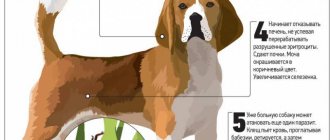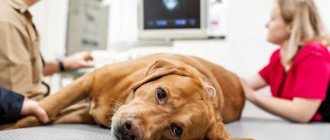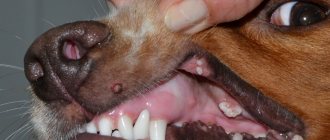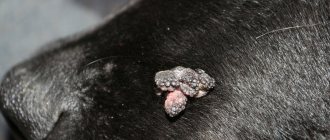Every responsible owner should know the first symptoms of pancreatitis in dogs, or inflammation of the pancreas. Despite its rarity, this disease is very dangerous. Without timely help, it can result in serious complications, including the premature death of the pet from sepsis.
Description and essence of the disease
The pathology develops against the background of disruption of the pancreas. This important organ is actively involved in the digestion process. It helps digest food, regulates metabolism and maintains normal blood sugar levels.
Characteristic
Once in the duodenum, food from the stomach is mixed with pancreatic enzymes. These substances break down all foods into their basic components, facilitating their absorption.
As a result of disruption of at least one of the functions in the movement of enzymes, a delay occurs. Accumulating inside the organ that produces them, they begin to corrode the surrounding tissue. This leads to severe intoxication of the body and inflammation of the gland.
Stages of development
In its development, the disease goes through 4 stages, differing from each other in symptoms and prognosis. These include:
- Initial
. Characterized by the manifestation of a pathological cause. Depending on the body's reaction, inflammation can manifest itself acutely or become chronic.
- Secondary
. Behavioral changes are complemented by physiological ones. There is a gradual increase in pain.
- Tertiary
. A collapsing gland provokes poisoning of nearby organs, causing disruptions throughout the body.
- Launched
. The patient has extensive necrosis and sepsis as a result of self-digestion and intoxication with decay products.
The disease is most easily treated in the first two stages. At the last stage, the prognosis is extremely unfavorable, since massive failure of internal organs is not compatible with life.
Classification of pathology
Pathology is divided into several types. For classification, the cause of occurrence and the nature of development are used.
Primary and secondary types
Primary inflammation develops independently, and secondary inflammation develops as a complication of other pathologies. In the first case, the cause is often poor nutrition or poisoning, so this type of disease is quite easy to treat. In the second case, the prognosis is less favorable, since problems in the pancreas are usually explained by systemic disorders.
Acute and chronic forms
Depending on the speed of development and severity of symptoms, pancreatitis in dogs is divided into acute and chronic. The likelihood of recovery in the first form is always higher, since the owners turn to the veterinarian at the initial stage of development.
But the chronic form often ends in death. Its symptoms become noticeable only at the third stage, when the degree of organ damage reaches 80%.
Acute attack of pancreatitis - first aid
If a dog has an attack of pancreatitis and all the pronounced symptoms are present, then the owner is obliged to provide him with first aid.
First of all, don't panic. Does your dog refuse to eat? Do not try to feed the animal. Hunger is the first rule during attacks of pancreatitis and the dog, subconsciously, knows about this.
Create complete peace for the animal, do not disturb it unnecessarily and provide maximum love. During attacks, the animal experiences severe fear and the smell of the hands of its beloved owner is the first medicine for it.
Reference! An attack of exacerbation of the pancreas is caused by severe pain. A possible way to alleviate a dog’s condition during an attack is to inject No-Shpa in the form of subcutaneous injections or in tablet form.
Of course, you first need to consult a veterinarian, he will tell you how many cubes should be given to the animal, depending on the weight. The owner will not be able to provide any other help for stomach cramps to the dog at home.
In any case, you will need to call a doctor at home or go to a veterinary clinic, so always keep the number of the doctor on duty at hand.
Causes of the disease
The owner himself is often to blame for a pet’s illness, neglecting recommendations for feeding and care. Lack of vitamins, infection with viruses and parasites, as well as injuries and prolonged stress can lead to quite serious consequences.
Dietary problems or poisoning
The danger is posed not only by a meager diet of dubious and monotonous products, but also by a sudden transition to a new type of food. An equally common cause is poisoning from food from the human table, scraps found in the trash, medicines, household chemicals and other dangerous substances left unattended.
Systemic disorders
This group includes gastrointestinal diseases (gastritis, cholecystitis, cirrhosis), obesity, endocrine disorders (diabetes mellitus, thyroid pathologies, hypercorticism), infection with liver worms and oncology. Here the owner can only influence the lack of excess weight and protection from parasites. Prevention of other pathologies comes down to regular examinations at the veterinary clinic.
Infection with bacteria or viruses
Neglect of vaccination and frequent contact with other animals are fraught with bacterial and viral infections. Complications on the digestive system are caused by parvovirus enteritis, adenovirus, plague and leptospirosis. All these diseases are included in the list of mandatory vaccinations that must be given before the age of one year.
Injuries
Problems with the pancreas occur when the abdominal cavity is injured. In addition to blows and bruises, the cause of organ damage may lie in unsuccessful sterilization or another operation involving dissection of the peritoneum.
Stress
Prolonged exposure to stress factors causes serious psychological disorders. Regularly experiencing negative emotions worsens overall well-being and reduces immunity. All this affects the functioning of internal organs and aggravates chronic diseases.
Genetic and breed predisposition
Pancreatitis is common in small breed dogs. The risk group includes:
- Yorkies;
- toy terriers;
- miniature poodles;
- dachshunds;
- Chihuahua.
All these animals have very sensitive digestion and nervous systems. For them, the cause of chronic pathology can be a one-time handout from the table or a short separation from their beloved owner.
It is also worth noting congenital developmental pathologies associated with abnormal organ structure. These disorders often run in families, so be sure to check the pedigrees of both parents when purchasing a puppy.
Feeding and diet during treatment
As described above, during the first day when the disease develops, the dog is prescribed a starvation diet. When feeding natural food, it will be very difficult for the owner to comply with nutritional standards, since the diet will be radically different from the usual one. The diet will be based on the fact that the diet will have to minimize the amount of carbohydrates and fats.
The cereal used is exclusively oatmeal, boiled without oil or salt. As the animal’s condition normalizes, lean meat and boiled tripe should be introduced. The scar is pre-washed and cleaned until it stops releasing green liquid when washed. Its clean meat is considered dietary. It is important to drink kefir or yogurt to restore the intestinal microflora, and when prescribing probiotics, use them as prescribed.
Pancreatin tablets are taken before meals so that they can be activated in the intestines. Only after this do they begin feeding. This removes the stress factor from the pancreas.
Important! A fractional feeding system is used! The total amount of food is divided into 5-6 times a day, and not into 1-2 as usual. Sweet, fried, salty, smoked, baked goods and other delicacies are prohibited!
If you use dry ready-made food, you should resort to holistic food. There are special foods for gastrointestinal diseases, pancreatitis, in fact. It is important to choose high-quality, proven brands. Monitor the deadlines on the packaging, the integrity and compliance of the packaging, check the barcode - beware of counterfeits! At the same time, supplementing feeding with natural kefir is not prohibited.
Symptoms of pancreatitis in dogs in different forms
The observed symptoms directly depend on the form of the disease. In the chronic form, signs of illness are absent most of the time, but in the acute form, they resemble an intestinal disorder.
For chronic
Chronic pathology develops over years. The body gradually destroys itself from the inside, causing the animal to experience mild symptoms of a common cold and indigestion.
You can suspect something is wrong by weak activity and poor appetite, as well as mild nausea and periodic diarrhea. Over time, symptoms include weight loss, yellowing of feces, trembling paws and dull fur.
Signs of this form of pancreatitis in dogs often alternate with prolonged remission. Despite this, you should not neglect the examination and wait for self-healing. Otherwise, the pet will simply die.
For acute
Accompanied by profuse vomiting, diarrhea, increased gas formation and abdominal pain. It occurs suddenly, causing a sharp deterioration in the condition. The most acute pain syndrome is observed during meals or shortly after feeding. The attack is accompanied by wheezing, rapid heartbeat and arching of the back.
Due to dehydration, the pet becomes very lethargic and drowsy. Its mucous membranes gradually turn yellow, signaling a violation of the outflow of bile.
Symptoms of pancreatitis
Pancreatitis, like many other diseases, can be acute or chronic.
Acute pancreatitis
The acute form of pancreatitis poses a threat to the dog’s life, as it can cause the rapid development of necrotic processes in the gland and further peritonitis. The symptoms of acute pancreatitis are very pronounced and cannot go unnoticed:
- severe weakening or lack of appetite;
- abdominal pain in the navel area - the dog whines or reacts aggressively to palpating the left side of the abdomen in the navel area;
- the general state of the body is depressed - the animal is lethargic and inactive;
- a sharp increase in body temperature;
- tachycardia (rapid heartbeat);
- heavy rapid breathing;
- extreme thirst due to dehydration;
- frequent vomiting, diarrhea, severe bloating.
If you notice that your dog is drinking water too often, contact your veterinarian. Photo: Aaron Fellmeth
Chronic pancreatitis
The signs of chronic pancreatitis are much less pronounced than acute pancreatitis, and often go unnoticed by the owner for a long time, which often leads to serious consequences (for example, diabetes):
- loss of appetite or refusal to eat;
- weight loss;
- infrequent vomiting, bloating (usually after eating);
- increased body temperature;
- lethargy, inactivity;
- change in the nature of feces (compaction or, conversely, liquefaction);
- deterioration of the coat, itching.
If you notice one or more of the above symptoms in your dog, contact your veterinarian for advice, this will help you avoid unwanted consequences.
Tests and diagnosis
The most informative analysis is a test for pancreatic lipase immunoreactivity. The only disadvantage of this study is the small number of laboratories with all the necessary equipment. For this reason, analysis is often based on:
- urine and blood tests that record deviations in basic indicators;
- Ultrasound, which determines the color, size and degree of damage to the abdominal organs;
- X-ray, recording tumors and foreign objects;
- a biopsy that allows you to study a fragment of the affected gland.
Individual treatment is prescribed after receiving all the results. Until this moment, the four-legged patient is treated according to the general scheme, since any delay is fraught with even greater destruction of the organ.
How to treat pancreatitis in a dog
Treatment methods for the pancreas in dogs depend on the degree of damage, concomitant pathologies and general health. Severe cases are treated strictly in a hospital, and mild cases are treated at home.
Drug therapy
Drug treatment of pancreatitis in dogs is based on relieving symptoms and eliminating possible causes. The organ itself cannot be restored, so it is very important not to miss the moment and to exclude its complete dysfunction.
Four-legged patients in serious condition are prescribed blood transfusions and placed on drips with infusion solutions to prevent dehydration. After eliminating vomiting and pain, pancreatic enzymes and antacids are prescribed. With their help, it is possible to normalize digestive function, reduce acidity and return to independent nutrition without inserting a probe. All other drugs are prescribed based on associated complications.
When is surgery needed?
Surgical treatment of pancreatitis in dogs is used for abscesses, necrosis, blockage of the bile ducts, neoplasms and lack of response to medications. Under general anesthesia, the surgeon sucks out excess free fluid and excises tumors and dead tissue.
In case of extensive inflammation, the peritoneum is carefully tightened, but not sutured. This is due to the need for periodic intervention for rinsing with saline solutions. The duration of this procedure is a week.
In case of pancreatitis, the dog's feeding must be changed. To reduce the load on the affected organ, a special therapeutic diet is used.
Pancreatitis in Yorkshire Terriers: symptoms, treatment, feeding
Some dog breeds have a high risk of developing pancreatitis from birth due to genetic inheritance. Yorkshire Terrier dogs have a vulnerable digestive system; violations of the selected diet provoke inflammation of the pancreas at the age of 4-5 years.
High-calorie foods, excess weight, abuse of bagged food, ill-considered transition from one type of feeding to another, drug and food poisoning lead to acute pancreatitis in Yorkies.
The main symptoms of the disease are: a sharp change in behavior, involuntary vomiting after feeding, sudden heavy shedding, frequent changes in bowel movements from diarrhea to constipation.
Diagnosis is carried out in a veterinary clinic, where clinical and biochemical tests (feces, blood, urine), X-rays and ultrasound examinations are performed.
Therapeutic treatment begins with injections to eliminate pain and vitamins that support the body; They give antiemetic tablets (coated), other necessary medications, and a portioned regimen of eating and drinking is prescribed.
During the recovery period, you should follow the instructions given by the veterinarian, especially regarding feeding rules: exclude raw meat and offal; It is forbidden to feed mixed food; you should use special food for Yorkshire terriers, including medicinal ones.
What to feed a dog with pancreatitis: diet principles
A diet for dogs with pancreatitis is not complete without temporary fasting. The duration of refusal to eat is selected individually. After pain relief, you must:
- Grind or puree foods, giving preference to liquid foods.
- Switch to fractional meals, that is, frequent feeding in small portions.
- Observe the temperature when serving the finished dish, avoiding too hot and cold food.
On a natural diet, it is recommended to use lean meat, water-based porridge, protein omelettes, carrot-zucchini puree and low-fat fermented milk products. If your pet eats dry kibble, choose ready-made food for dogs with pancreatitis that contains the i/d mark.
Treatment
Unfortunately, there are no specific drugs to rid a dog of pancreatitis. The addition of enzymes that are used in humans (Pancreatin, Creon) is often not justified, since these substances are usually sufficient, and the problem lies elsewhere.
The tactics of approaching a patient with pancreatitis boils down to reducing inflammation, relieving symptoms, and normalizing the diet. Surgical treatment may be necessary for pancreatic abscess or blocked ducts.
Be sure to read the instructions included with the drug before using it!
| Anesthesia | Improved digestion | Droppers | From vomiting |
| Ketamine – available for use only in a clinic with a drug permit | Cerucal – for decreased intestinal peristalsis | Sodium chloride 0,9% | Serenia |
| Noropin - in severe cases, administered into the abdominal cavity through an installed drainage | Ranitidine is a gastroprotector | Ringer's solution | Ondasentron |
| Droppers with lidocaine | Pancrealex is a homeopathic remedy that can be used as part of complex therapy | Transfusion of donor blood plasma | Cerucal |
Antibiotics for pancreatitis in dogs
The use of antimicrobial drugs for the treatment of pancreatitis in dogs is a controversial issue, because unlike cats, with their structural features of the excretory ducts of the pancreas, in canines the process of inflammation often occurs under sterile conditions.
However, when there are signs and to prevent a bacterial infection, as well as in the presence of concomitant diseases, antibiotics can be used.
The course is 10-21 days.
The route of administration, depending on the duration of use, the type of drug and the condition of the dog, can be intravenous, intramuscular or oral.
Be sure to read the instructions included with the drug before using it!
| Antibiotic name | Dosage |
| Sinulox | 12.5 mg/kg |
| Tylosin | 0.1-0.2 ml per kg |
| Trichopolum | 12 mg/kg |
| Kobaktan | 1 ml/10 kg |
| Marfloxin | 2 mg/kg |
Feeding and diet during treatment
Unlike people, animals cannot starve. A dog's diet for pancreatitis should be:
- Fractional;
- Small portions;
- Low Fat;
- Selected by a veterinarian.
Feeding can be done using both industrial diets and homemade food.
Food for dogs with pancreatitis is available from different manufacturers in dry and wet form:
- Monge gastrointestinal;
- Hills i/d low fet.
- Royal Canin gastrointestinal low fet.
- Proplan H/A.
- Happy dog intestinal low fet.
Conventional food and diets are often not suitable for the digestive system, as they contain a high percentage of fat content. Before giving your pet a treat, consult your veterinarian or read the recommendations on the packaging or the manufacturer's website.
It is better to avoid treats during treatment.
If you decide to stick to homemade food, then you should pay attention to the fact that feeding “from the table” or just anything will not work. Your pet will need to have special food prepared regularly. It is better for the diet to be compiled by a nutritionist and balanced in terms of nutrients, vitamins and minerals.
List of foods that should not be given to a dog with inflammation of the pancreas:
- Fatty meats and fish;
- Fermented milk products with high lipid content;
- Egg yolk;
- Fried food;
- Raw foods;
- Salty;
- Sour;
- Sweet;
- Spices;
- Flour;
- New foods for dogs;
- Treats.
And now a selection of what is allowed to feed a dog with pancreatitis:
- Meat and offal : skinless and boneless chicken, turkey, rabbit, nutria.
- Vegetables : cucumber, zucchini, pumpkin, carrots.
- Cereals in limited quantities, no more than 10-15 percent of the total diet: rice, buckwheat;
- Dairy products : kefir, biolact, cottage cheese. Without sweet additives and low fat content;
- Fruits : apple, pear.
Feeding frequency 6-8 times a day . It is necessary to provide access to cool, fresh water.
If the animal has uncontrollable vomiting, refusal to eat and lethargy, then the veterinarian may decide to insert a feeding tube. It can be inserted through the nose, esophagus, or directly into the intestines.
We recommend that you read the article: “Obesity and diseases of dogs associated with excess weight.”
Possible complications
Acute inflammation is fraught with internal bleeding, thrombosis, respiratory and liver failure, and chronic inflammation is fraught with fistulas, oncology and secondary infection. Due to a drop in immunity, the body cannot fight back against pathogenic microorganisms, which leads to purulent abscesses and death from blood poisoning.
The most dangerous complications include pancreatic necrosis, that is, death of pancreatic tissue. With this diagnosis, the probability of recovery is only 10%.











